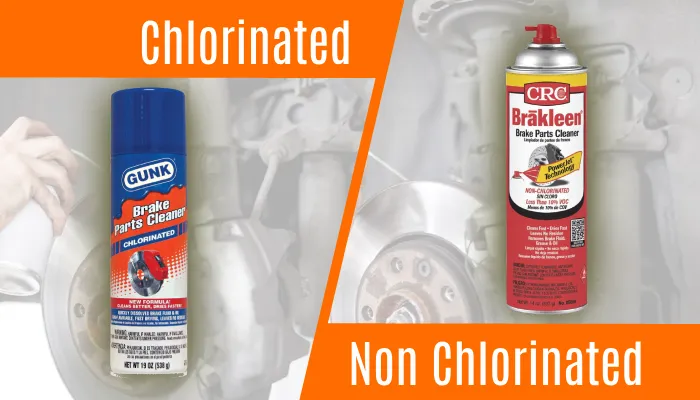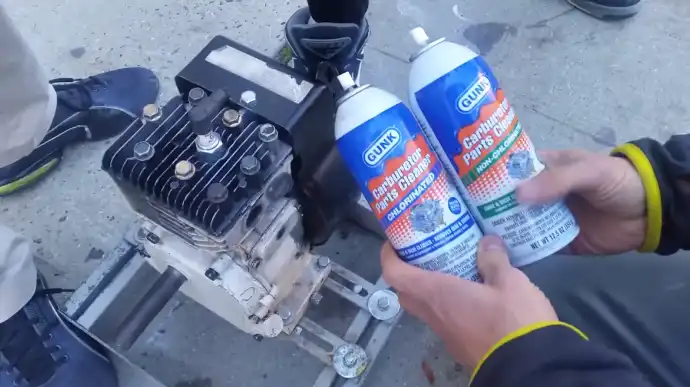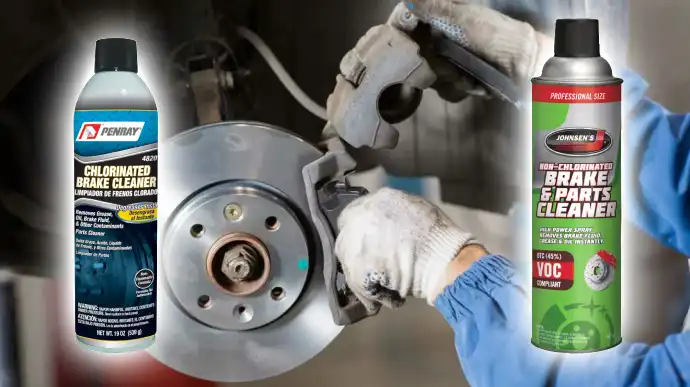Physical Address
304 North Cardinal St.
Dorchester Center, MA 02124
Physical Address
304 North Cardinal St.
Dorchester Center, MA 02124

A brake cleaner is an essential tool for maintaining the safety and performance of your vehicle’s braking system. When choosing the right brake cleaner, one of the key decisions you’ll face is whether to opt for chlorinated or non-chlorinated variants.
Chlorinated brake cleaners contain potent solvents like Perchloroethylene and Methylene Chloride. They are highly effective but can be toxic and flammable, posing health and environmental risks.
Non-chlorinated brake cleaners use milder solvents like acetone and isopropyl alcohol. It provides a safer and more environmentally friendly option, albeit with slightly reduced cleaning power.
Throughout this article, we’ll explore which option cleans better, how brake cleaner can improve performance. Also, we will discuss whether WD-40 can be a substitute and how long brake cleaner lasts. Get ready to discover the most efficient way to keep your brakes in top shape.

Regarding comparing chlorinated and non-chlorinated brake cleaners for vehicles, there are several key differences to consider.
Chlorinated brake cleaners contain volatile organic compounds (VOCs) such as Perchloroethylene, Methylene Chloride, and Trichloroethylene. These compounds are highly effective solvents for cleaning brake parts. They’ve strong degreasing properties and can easily remove brake dust, oil, and other contaminants.
On the other hand, non-chlorinated brake cleaners use alternative chemicals like acetone, heptane, and isopropyl alcohol. These solvents are less environmentally harmful but can still effectively dissolve grease and grime.
Despite their inferior power, non-chlorinated brake cleaners are still capable of cleaning brake systems adequately.
Chlorinated brake cleaners are known for their quick-drying properties. When applied to metal brake parts, they evaporate rapidly, leaving behind a dry surface in a short amount of time. This is advantageous as it allows for immediate reassembly and minimizes the risk of moisture-related issues.
In contrast, non-chlorinated brake cleaners have a longer drying time than their chlorinated counterparts. This is because they contain different solvents that evaporate at a slower rate.
While this may prolong the cleaning process slightly, you should allow sufficient time for the brakes for drying to ensure that any residue is removed.
Chlorinated brake cleaners offer a lower flammability risk compared to non-chlorinated options, making them a safer choice for certain applications.
While both types of brake cleaners can be flammable, the presence of chlorine in the formulation of chlorinated brake cleaners helps to reduce their flammability. This is because chlorine acts as a flame retardant, inhibiting fire spread.
However, it’s important to note that chlorinated brake cleaners can still be flammable, especially in the presence of ignition sources. Therefore, caution should still be exercised when using them.
Contrary to this, non-chlorinated brake cleaners tend to have a higher flammability risk. This means that extra care and proper safety measures should be taken when using non-chlorinated options to minimize the risk of fire or ignition.
Using a highly toxic substance, chlorinated brake cleaner poses significant health risks when compared to non-chlorinated options.
Chlorinated brake cleaners contain chemicals like Tetrachloroethylene and Methylene Chloride, known to have adverse health effects.
These substances have been linked to respiratory irritation, dizziness, nausea, and even long-term effects such as liver and kidney damage. In addition, they’ve been classified as potential carcinogens.
Additionally, non-chlorinated brake cleaners may contain chemicals like heptane and n-hexane, which also pose health risks and are flammable. These chemicals can cause skin irritation, eye damage, and respiratory problems.
Chlorinated brake cleaners are highly effective due to their strong solvency power. They can easily dissolve brake fluid, dust, grease, and other contaminants that accumulate on metal brake parts. This helps to ensure optimal brake performance and safety.
Non-chlorinated alternatives, while not as potent, still offer a good level of effectiveness. They’re capable of outperforming water-detergent solutions, especially when cleaning paint and other materials.
However, for heavy-duty cleaning tasks, chlorinated brake cleaners are the preferred choice due to their superior solvency.

To ensure the longevity of your brake cleaner, it’s important to consider the differences in shelf life between chlorinated and non-chlorinated options.
Chlorinated brake cleaners typically have a longer shelf life due to their quick-drying nature. The chlorine content in these cleaners helps to accelerate the evaporation process, reducing the risk of product deterioration over time.
Conversely, non-chlorinated brake cleaners may have a shorter shelf life as they tend to evaporate more slowly. This slower evaporation rate can result in the accumulation of moisture and contaminants in the product, leading to reduced effectiveness and potential damage to your vehicle’s braking system.
Chlorinated brake cleaners, although more aggressive in removing brake dust and other contaminants, can negatively impact the resilience of certain rubber or plastic components in your vehicle’s brake system.
The chlorine compounds in these cleaners can cause rubber seals, gaskets, and hoses to deteriorate over time, leading to potential leaks and reduced performance.
Meanwhile, non-chlorinated brake cleaners are formulated to be gentler and less likely to affect the resilience of rubber or plastic parts. They can effectively clean your brake system without causing any significant damage.
Therefore, if you want to maintain the surface resilience of your vehicle, it’s recommended to opt for non-chlorinated brake cleaner.
When choosing between chlorinated and non-chlorinated brake cleaner for your vehicle, it’s important to consider the differences in regulatory compliance.
Chlorinated brake cleaners can pose compliance issues due to their higher volatile organic compound (VOC) emissions, which may exceed the regulations in certain regions. These higher emissions contribute to air pollution and can negatively affect human health and the environment.
On the other hand, non-chlorinated brake cleaners generally comply better with local regulations, as they emit lower levels of VOCs. However, it’s crucial to verify the product’s compliance in all 50 states, as regulations may vary.
Chlorinated brake cleaners are generally more affordable compared to non-chlorinated ones. This is because chlorinated brake cleaners use chemicals that are less expensive to produce.
On the other hand, brake cleaners without chlorination tend to be slightly more expensive because they use safer and less harmful chemicals. It may be more difficult to find non-chlorinated brake cleaners, but they are still available in specialized automotive stores and online.
| Aspect | Chlorinated Brake Cleaner | Non-Chlorinated Brake Cleaner |
| Solvent Composition | Perchloroethylene, Methylene Chloride, Trichloroethylene | Acetone, Heptane, Isopropyl Alcohol |
| Drying Time | Quick-drying | Longer drying time |
| Flammability | Lower flammability risk, chlorine acts as a flame retardant | Higher flammability risk, requires extra care and precautions |
| Toxicity and Health Risks | Contains highly toxic substances, potential carcinogens | Health risks, flammable, can cause skin, eye, and respiratory issues |
| Effectiveness | Highly effective for heavy-duty cleaning tasks | Effective, especially for paint and other materials |
| Shelf Life | Longer shelf life due to quick-drying nature | Shorter shelf life, slower evaporation may lead to moisture accumulation |
| Surface Resilience | Aggressive, may negatively impact rubber/plastic components | Gentler, less likely to affect resilience of rubber/plastic parts |
| Regulatory Compliance | May pose compliance issues due to higher VOC emissions | Generally complies better with local regulations, lower VOC emissions |
Burning chlorinated brake cleaner can release harmful or fatal corrosive gasses such as hydrogen chloride and phosgene. It is important to avoid using the product near open flames, welding operations, or excessive heat to mitigate these risks.
Chlorinated brake cleaner is designed to quickly and effectively remove brake dust, brake fluid, grease, and other contaminants without leaving any residue behind.
Non-chlorinated brake cleaner is classified as an extremely flammable aerosol and can explode if heated. It is important to adhere to proper handling and usage procedures to avoid any accidents or hazards.

Non-chlorinated brake cleaner is safe to use on rubber and most types of automotive plastics. This makes it a versatile and effective solution for cleaning and maintaining all types of brake systems, including those with ABS technology.
The choice between chlorinated and non-chlorinated brake cleaners ultimately depends on your specific needs and priorities.
Chlorinated brake cleaners may offer superior cleaning power but come with safety and environmental concerns. Non-chlorinated alternatives are safer and more environmentally friendly, even though they may require a little more time and effort for effective cleaning.
Whichever option you choose, it’s crucial to prioritize safety, follow product instructions, and ensure compliance with local regulations. Proper brake maintenance is essential for vehicle safety, and selecting the right brake cleaner is an important step in this process.